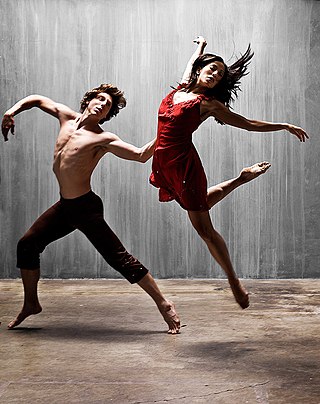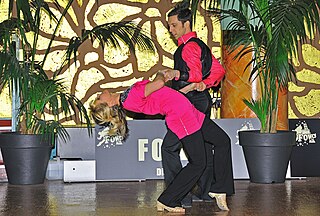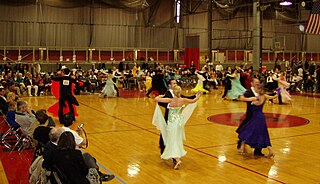Related Research Articles

Ballroom dance is a set of partner dances, which are enjoyed both socially and competitively around the world, mostly because of its performance and entertainment aspects. Ballroom dancing is also widely enjoyed on stage, film, and television.

Dance is an art form consisting of sequences of body movements with aesthetic and often symbolic value, either improvised or purposefully selected. Dance can be categorized and described by its choreography, by its repertoire of movements, done simultaneously with music or with instruments; or by its historical period or place of origin.
Jazz dance is a performance dance and style that arose in the United States in the mid 20th century. Jazz dance may allude to vernacular jazz about to Broadway or dramatic jazz. The two types expand on African American vernacular styles of dance that arose with jazz music. Vernacular jazz dance incorporates ragtime moves, Charleston, Lindy hop and mambo. Popular vernacular jazz dance performers include The Whitman Sisters, Florence Mills, Ethel Waters, Al Minns and Leon James, Frankie Manning, Norma Miller, Dawn Hampton, and Katherine Dunham. Dramatic jazz dance performed on the show stage was promoted by Jack Cole, Bob Fosse, Eugene Louis Faccuito, and Gus Giordano.
In some types of partner dance, lead and follow are designations for the two dancers' roles in a dance pairing. The leader is responsible for guiding the couple and initiating transitions to different dance steps and, in improvised dances, for choosing the dance steps to perform. The leader communicates choices to the follower, and directs the follower by means of subtle physical and visual signals, thereby allowing the pair to be smoothly coordinated.

West Coast Swing is a partner dance with roots in the Lindy Hop. It is characterized by an elastic look that results from its extension-compression technique of partner connection and is danced primarily in a slotted area on the dance floor. The dance allows for both partners to improvise steps while dancing together, putting West Coast Swing in a short list of dances that emphasize improvisation.
The Balboa is a swing dance that originated in Southern California during the 1920s and enjoyed huge popularity during the 1930s and 1940s.

Salsa is a Latin dance, associated with the music genre of the same name, which was first popularized in the United States in the 1960s in New York City. Salsa is a mixture of Cuban dances, such as mambo, pachanga and rumba, as well as American dances such as swing and tap.

Social dances are dances that have a social functions and context. Social dances are intended for participation rather than performance. They are often danced merely to socialise and for entertainment, though they may have ceremonial, competitive and erotic functions.

Latin dance is a general label, and a term in partner dance competition jargon. It refers to types of ballroom dance and folk dance that mainly originated in Latin America.

Modern social round dance, or round dancing, is a choreographed and cued ballroom dance that progresses in a circular counter-clockwise pattern around the dance floor. The two major categories of ballroom dances found in round dancing are the smooth and international ballroom styles and the Latin dances. It is not to be confused with circle dancing, which is a type of folk dance in which dancers are connected in a circular chain.

Dancesport is competitive ballroom dancing, as contrasted to social or exhibition dancing. In the case of Para dancesport, at least one of the dancers is in a wheelchair.
This is a list of dance terms that are not names of dances or types of dances. See List of dances and List of dance style categories for those.
Rhumba, also known as ballroom rumba, is a genre of ballroom music and dance that appeared in the East Coast of the United States during the 1930s. It combined American big band music with Afro-Cuban rhythms, primarily the son cubano, but also conga and rumba. Although taking its name from the latter, ballroom rumba differs completely from Cuban rumba in both its music and its dance. Hence, authors prefer the Americanized spelling of the word (rhumba) to distinguish between them.
In many forms of dance medal examinations are held. They are organised by leading dance teaching organisations, such as the Imperial Society of Teachers of Dancing (ISTD), the International Dance Teachers Association (IDTA), and other organisations.

Sequence dancing is a form of dance in which a preset pattern of movements is followed, usually to music which is also predetermined. Sequence dancing may include dances of many different styles. The term may include ballroom dances which move round the floor as well as line, square and circle dances.

Walter William Laird was a major influence in the development of Latin American dancing in Britain after the Second World War. He was World Professional Latin Dance Champion three times. He coached many successful dancers including Allan Tornsberg, Vibeke Toft, Espen Salberg, Jukka Haapalainen, Sirpa Suutari, Donnie Burns & Ian Waite. Peter Maxwell & Lynn Harman were amongst his first major champions and a couple on which much of his ultimate technique was developed. Laird was a Fellow and Examiner of the IDTA, and until 2000, he was Secretary of the Ballroom Dancers' Federation.
Alexander Reuben Percy Moore (1901–1991) was an English ballroom dancer from Stourbridge. He was a pioneer of modern ballroom dancing, a leading adjudicator and organiser, a dance teacher of international renown and the author of classical ballroom dancing texts. His Ballroom Dancing is considered to be the 'Bible' of International-style ballroom dancing.
Juliet E. McMains is a United States dance scholar and instructor, the author of the Glamour Addiction, the first comprehensive study of the United States DanceSport.
Dimitri Petrides was a ballroom dancer who was instrumental in pioneering and developing Latin American dancing in England and later globally. He left Cyprus when he was eighteen with his mother after the death of his father, eventually settling in England. He was one of the founding members of the Latin-American Faculty of the Imperial Society of Teachers of Dancing, and wrote the first English textbook on the subject. He was a Fellow and Examiner of the ISTD.

The Lindy Hop is an American dance which was born in the Black communities of Harlem, New York City, in 1928 and has evolved since then. It was very popular during the swing era of the late 1930s and early 1940s. Lindy is a fusion of many dances that preceded it or were popular during its development but is mainly based on jazz, tap, breakaway, and Charleston. It is frequently described as a jazz dance and is a member of the swing dance family.
References
- ↑ "Dance fever: Recovery can be hard" Archived 2009-01-20 at the Wayback Machine , an article about the book and the author at the University of Washington newspaper, University Week, November 30, 2006
- ↑ A review of Glamour Addiction in the Dance Research Journal, Volume 40, Number 1, Summer 2008